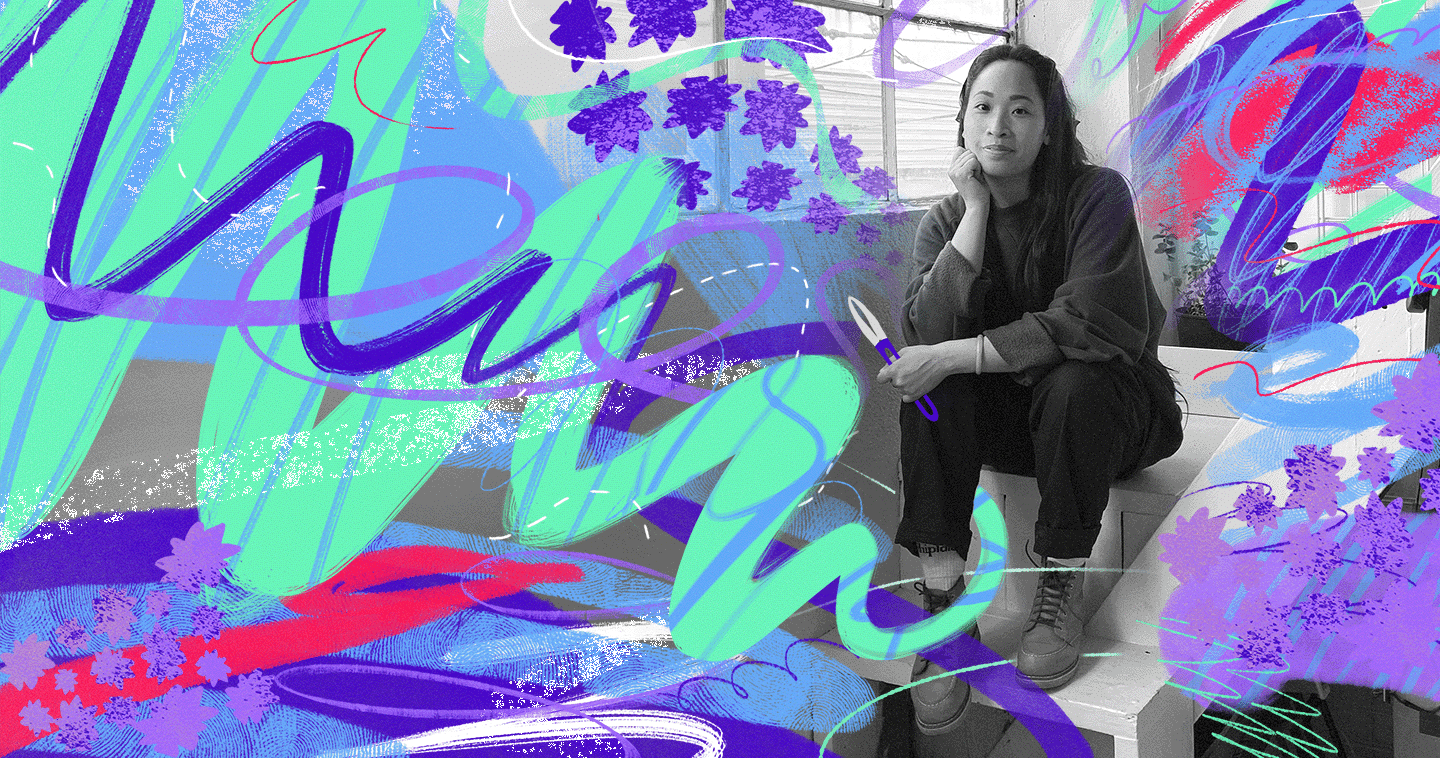What’s Your Create: Amy Guan
Amy Guan explores how she balances the digital and the analog as the sole proprietor of a soft goods business.
Amy Guan’s spacious studio appears in the tiny frame of a video call. Simple, white lines and dollops of color give the studio shape, and the sun spills out of the window, opening to a breezy Bay Area view. A compact staircase alludes to a lofted floor that any creator would covet. Her space is elegant and measured, a perfect home for Modokot, Guan’s custom handbags business.
Despite making each bag by hand, Guan’s practice is leavened by technology. Her work exists at the intersection of tradition and modernity, analog and digital. Without that balance, Modokot wouldn’t exist.
“I don’t think technology and working with your hands are mutually exclusive, I think they complement each other really well,” said Guan. “I am constantly trying to merge these two worlds to try and create a meaningful medium for myself.”
Craft, tempered by technology, fuels Modokot.
Reprioritizing
Guan’s love for fabrics and working with her hands starts with her mother, who sewed in her home of Hoiping before working for Levi-Strauss after immigrating to the United States. Like any parent, her mother wanted Guan to get an education and a good job, to avoid the toil that she’d endured.
Guan eventually did land a great job at a local tech giant after college, but she felt that something was missing. It wasn’t until the COVID-19 pandemic, though, that Guan had the space to explore that feeling.
“During the pandemic, I realized there was so much about my job that made me feel stuck,” Guan recalled, “so I tried to think about my passions and how I could embrace them.”
In the throes of lockdown, Guan took to working with fabrics, like her mother. She found the analog nature of the work restorative after a day full of screens and Zoom fatigue. The pristine walls took on new forms, as she recounted the lockdown era, especially through the lens of a video call. Her work, her passion, was forged here, in the corporeal corners of a digital life.
“I started making bags during the pandemic and realized I could make a living at this,” said Guan. “I knew I couldn’t let my passion go to waste, so on July 1st, 2021, Modokot was born.”
Tradition and modernity
The name Modokot is a Taishanese word Guan remembers her grandmother saying often, which means nothing goes to waste. A fitting name for Guan’s new chapter which blends tradition and modernity.
Guan’s mother was shocked when her daughter said she wanted to work with her hands, to leave her modern job for a painstakingly traditional trade. Her daughter saw it differently.
“During the pandemic, people were interested in that human touch, in slow fashion. But, that work is hard, it’s needle-by-needle, as my mom would say,” Guan explained. “I wanted to find a way to blend that ethic with new ideas and styles.”
It began with Guan choosing non-traditional fabrics and patterns for her bags. Now she’s adding new features, shapes, and techniques to her craft. At first, her mother wasn’t sure about this new path, but Guan now collaborates with her mom. While Guan constantly pushing forward, her mother anchors her in tradition, balancing the designs.
“I want to add my own flair and I’m so forward-thinking, but her insight is very traditional, very practical,” said Guan, “I really value her input because I need that balance in my bags.”
Digital and Analog
In the creative process, Guan prefers to stay grounded in the analog world. Notebooks overflow with her ideas, prototype bags are marked with measurements, and Guan keeps a mental ledger of every detail while prototyping a design.
“I do everything with pencil and paper or directly with the fabric,” she said, “I’ll use white canvas and I’ll write measurements on the canvas, so I can see the measurements as I work. If I make a change, I can cross it out and write it on the fabric.” She flashes pieces and prototypes in front of the camera, marked with lines and scribbles, like a virtual gallery of her craft.
Her work is immersive, and Guan knows all the specifications of her bags by heart. Technology comes in to supplement that tactile joy, to keep her mind on the fabrics and away from the aspects of the business that drain her.
“Because I’m just a one-person show, I have to make sure that I’m maximizing my time and energy, and one way of doing that is leveraging technology,” Guan said. “For example, writing product copy is hard for me, so I’ve been using AI to help me write. Instead of spending an hour on one blurb, I can get it done in minutes.”
Selling the bags is another area where technology aids Guan. While in-person markets were once an important part of her word-of-mouth growth, engaging with textile and maker communities online is now a bigger part of her marketing.
“Leveraging the in-person connections have been critical because it’s allowed me to slowly integrate my work into the world, but my bags really thrive online and I sell all over the world,” she said, “so it’s about leveraging and balancing in-person and technology.”
Creating through balance
In many ways, Guan’s creative process and business are built upon a renegotiation of her relationship with technology. Modokot isn’t the analog, needle-by-needle work of her mother. But, it’s not the stuck feeling Guan had in her previous job either.
“I think there’s a theme of balance in my work: balance with the materials, with tradition and modernity, with tech and analog,” Guan said. Her new life is built on a creative process that is more than craft or technology on their own.
“My creative process is about how my body connects to my work, to technology, to my audience.”
What’s Your Create? is a new series from Western Digital that explores creators in all disciplines using technology to enhance their craft.
Artwork by Cat Tervo




